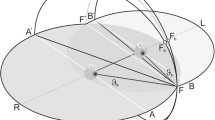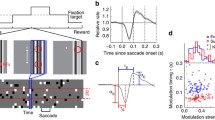Abstract
A model for the generation of oblique saccades is constructed by extending and modifying the one dimensional local feedback model. It is proposed that the visual system stores target location in inertial coordinates, but that the feedback loop which guides saccades works in retinotopic coordinates. To achieve straight trajectories for centripetal and centrifugal saccades in all meridians, a comparator computes motor error as a vector and uses the vectorial error signal to drive two orthogonally-acting burst generators. The generation of straight saccade trajectories when the extraocular muscles are of unequal strengths requires the introduction of a burst-tonic cell input to motor neurons. The model accounts for the results of two-site stimulation of the superior colliculus and frontal eye fields by allowing simultaneous activation of more than one comparator. The postulated existence of multiple comparators suggests that motor error may be computed topographically.
Similar content being viewed by others
References
Albano, J., Wurtz, R.: Deficits in eye position following ablation of monkey superior colliculus, pretectum, and posterior-medial thalamus. J. Neurophysiol. 48, 318–337 (1982)
Becker, W., King, W., Fuchs, A., Jürgens, R., Johansen, G., Kornhuber, H.: Accuracy of goal-directed saccades and mechanisms of error correction. In: Progress in oculomotor research, pp. 29–37. Fuchs, A., Becker, W., eds. North-Holland; Elsevier 1981 (Developments in Neuroscience 12)
Evinger, C., Kaneko, C., Fuchs, A.: Oblique saccadic eye movements in the cat. Exp. Brain Res. 41, 370–379 (1981)
Fuchs, A.: Discussion summary. In: Progress in oculomotor research, pp. 115–121. Fuchs, A., Becker, W., eds. North-Holland: Elsevier 1981 (Developments in Neuroscience 12)
Guthrie, B., Porter, J., Sparks, D.: Corollary discharge provides accurate eye position information to the oculomotor system. Science 221, 1193–1195 (1983)
Hallett, P., Lightstone, A.: Saccadic eye movements to flashed targets. Vision Res. 16, 107–114 (1976)
Hepp, K., Henn, V.: Spatio-temporal recoding of rapid eye movement signals in the monkey paramedian pontine reticular formation (PPRF). Exp. Brain Res. 52, 105–120 (1983)
Keller, E.: Oculomotor specificity within subdivisions of the brain stem reticular formation. In: The reticular formation revisited, pp. 227–240. Hobson, J., Brazier, M., eds. New York: Raven Press 1980
King, W., Fuchs, A.: Reticular control of vertical saccadic eye movements by mesencephalic burst neurons. J. Neurophysiol. 42, 861–876 (1979)
King, W., Lisberger, S., Fuchs, A.: Horizontal and vertical components of oblique saccades are temporally coupled in humans and monkeys. Soc. Neurosci. Abstr. 9 (Part 1), 68 (1983)
Maldonado, H., Joseph, J.-P., Schlag, J.: Types of eye movements evoked by thalamic microstimulation in the alert cat. Exp. Neurol. 70, 613–625 (1980)
Robinson, D.: Eye movements evoked by collicular stimulation in the alert monkey. Vision Res. 12, 1795–1808 (1972)
Robinson, D.: A quantitative analysis of extraocular muscle cooperation and squint. Invest. Ophthalmol. 14, 801–825 (1975)
Robinson, D., Fuchs, A.: Eye movements evoked by stimulation of frontal eye fields. J. Neurophysiol. 32, 637–648 (1969)
Robinson, D., Zee, D.: Theoretical considerations of the function and circuitry of various rapid eye movements. In: Progress in oculomotor research, pp. 3–12. North-Holland: Elsevier 1981 (Developments in Neuroscience 12)
Schiller, P., Sandell, J.: Interactions between visually and electrically elicited saccades before and after superior colliculus and frontal eye field ablations in the rhesus monkey. Exp. Brain Res. 49, 381–392 (1983)
Scudder, C.: A different local feedback model of the saccadic burst generator. Soc. Neurosci. Abstr. 10 (Part 2), 910 (1984)
Sparks, D., Holland, R., Guthrie, B.: Size and distribution of movement fields in the monkey superior colliculus. Brain Res. 113, 21–34 (1976)
Sparks, D., Mays, L.: Movement fields of saccade-related burst neurons in the monkey superior colliculus. Brain Res. 190, 39–50 (1980)
van Gisbergen, J., Robinson, D., Gielen, S.: A quantitative analysis of generation of saccadic eye movements by burst neurons. J. Neurophysiol. 45, 417–442 (1981)
van Gisbergen, J., van Opstal, A., Schoenmakers, J.: An analysis of component-crosscoupling in oblique saccades. Soc. Neurosci. Abstr. 10 (Part 2), 909 (1984)
Yarbus, A.: Eye Movements and Vision. New York: Plenum Press 1967
Author information
Authors and Affiliations
Rights and permissions
About this article
Cite this article
Tweed, D., Vilis, T. A two dimensional model for saccade generation. Biol. Cybern. 52, 219–227 (1985). https://doi.org/10.1007/BF00336978
Received:
Issue Date:
DOI: https://doi.org/10.1007/BF00336978




